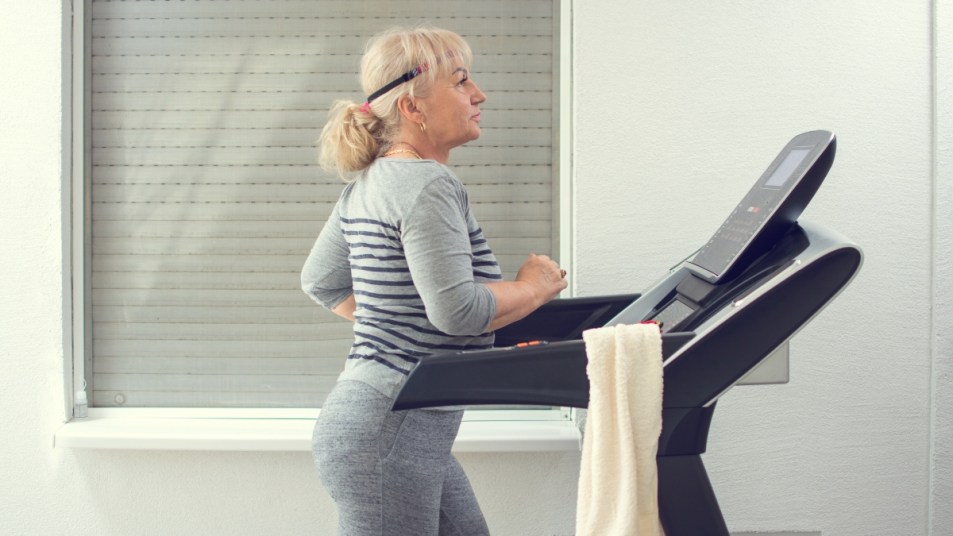This Easy Exercise May Lower Your Risk of Long COVID Symptoms, Diabetes, and Depression

While the race to find a cure for long COVID is well underway, researchers and doctors are still struggling to treat the disease in the present moment. Long COVID, or the long-lasting health problems that arise after an acute COVID-19 infection, can cause a slew of debilitating symptoms. However, there is something we can do to reduce our likelihood of developing this chronic condition. New research suggests that exercise may reduce the inflammation that sparks long COVID symptoms like diabetes and depression.
Long COVID might not seem like a particularly important health focus, especially with America’s case numbers on the decline. But the data tells us otherwise. Even a mild infection can cause long COVID, and women are more likely to be infected than men. The American Medical Association (AMA) estimates that 10 to 30 percent of patients develop the long-lasting illness. Penn State researchers believe that half of COVID survivors will experience lingering symptoms for six months. No matter which estimate is true, finding ways to combat enduring symptoms is incredibly important for long-term health.
Why Exercise Could Ease Long COVID Symptoms
In a scientific paper published in Exercise and Sport Sciences Reviews, researchers from the Pennington Biomedical Research Center noted that long COVID creates inflammation, which can worsen existing diabetes or cause diabetes to develop. (Diabetes may even develop six months later, long after the acute infection has passed.) In addition, 30 to 40 percent of patients develop anxiety and depression after a COVID-19 infection. At the same time, the researchers noticed that a lack of physical exercise is linked to a higher risk of severe COVID. They wondered if the opposite were true — that exercise could prevent or ease symptoms of long COVID.
The authors cited a number of previous studies on exercise, diabetes, and depression to support their theory. For instance, they referred to a 2017 study which found that regular exercise alleviated symptoms of depression. Another 2017 study showed that repetitive exercise improves glucose tolerance and insulin sensitivity in people who are insulin resistant or have type 2 diabetes.
In addition, working out may reduce cortisol levels (the stress hormone), which could translate into better health. The study authors also pointed to a 2000 study, during which volunteers with major depressive disorder exercised on a regular basis. After they did so, the volunteers experienced significant improvement in their symptoms. The reason? Exercise elevated levels of serotonin (a chemical messenger that may help stabilize mood). More recently, Harvard Health reported that exercise may be as effective as antidepressants in some cases. (However, they did not that it should be combined with other treatments.)
“We know that Long COVID causes depression, and we know that it can increase blood glucose levels to the point where people develop diabetic ketoacidosis, a potentially life-threatening condition common among people with type 1 diabetes,” Candida Rebello, PhD, study author, and research scientist at Pennington Biomedical Research Center, explained in a press release. “Exercise can help. Exercise takes care of the inflammation that leads to elevated blood glucose and the development and progression of diabetes and clinical depression.”
As a result, and because it is a free form of treatment, exercise may be an extremely important component in recovery plans for COVID-19 and long COVID patients.
How to Exercise to Reduce Risk of Long-COVID Symptoms
What sort of exercise should you do after you’ve recovered from an acute COVID-19 infection? As explained by Dr. Rebello, it doesn’t have to be much. “You don’t have to run a mile or even walk a mile at a brisk pace,” she said. “Walking slowly is also exercising. Ideally, you would do a 30-minute session of exercise.”
Don’t have time for 30 minutes? Try splitting your walks into two 15-minute rounds daily. And if you only have 15 minutes, just exercise for that amount of time. The idea is to start somewhere — something is better than nothing.
As with any lifestyle change, it’s a great idea to speak to your doctor first. A doctor will be able to offer you the best advice on how to get back into exercise post-COVID, and recommend workouts that are safe for you to do. And if you haven’t yet gotten your COVID-19 vaccine, schedule an appointment! Getting the vaccine is one of the best ways you can protect yourself from severe illness and long-lasting symptoms.
















